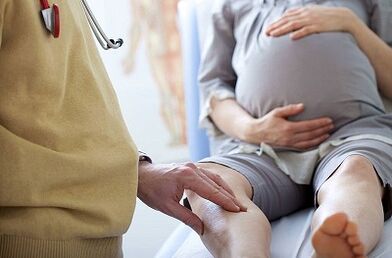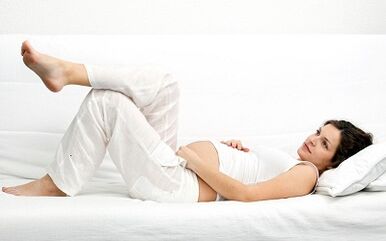Expecting a baby is undoubtedly a wonderful time in the life of any representative of the fairer sex.But it is often associated with various anxieties and complications.One of these is varicose veins during pregnancy.The growth of the fetus puts a lot of stress on a woman’s legs, sometimes the blood vessels can’t stand it, and this unpleasant illness occurs.It not only spoils the aesthetic appearance, but can be quite dangerous to health and even life.More about this in the article.
Main causes of pathology
Varicose veins in pregnant women are a fairly common occurrence; every third woman experiences it.
There are several reasons for the appearance of varicose veins during pregnancy:
- The composition of the blood changes; fibrinogen increases during pregnancy.It is “responsible” for blood viscosity.This means that the blood becomes thicker, it is more difficult to move through the vessels, and normal blood flow is disrupted.Therefore, the veins cannot stand it and expand.Also, as fibrinogen increases, the likelihood of blood clots increases.
- An increase in progesterone in the blood is an unfavorable factor for blood vessels.The fact is that this hormone reduces the tone of the uterus, protecting the body from miscarriage and premature birth.And at the same time, vascular tone decreases.
- Blood volume almost doubles during pregnancy; this increase leads to the fact that the vessels cannot cope with the unusual volume of blood and become deformed.
- As mentioned above, fetal growth creates increased pressure on the blood vessels.
In addition, a woman may have indirect unfavorable factors for the development of varicose veins during pregnancy:
- hereditary factor;
- rapid weight gain;
- insufficient presence of fiber and vitamins in the pregnant woman’s diet;
- low mobility.
If the mother suffered from varicose veins on her legs during pregnancy, then her daughter will most likely have this problem.
Symptoms of varicose veins during pregnancy

At the beginning of the disease, a woman may not feel any symptoms at all.Then spider veins and spider veins appear.But few people pay attention to them.But when swelling of the legs appears in the evenings, as well as night cramps, many become wary.
Next, the veins become visible to the naked eye; they “extend” to the surface of the skin of the legs.This not only spoils the appearance, but also causes concern.After all, it could be even worse!Indeed, blood clots can form in dilated veins, and this already threatens the life of the woman and the fetus.
It is impossible to completely cure varicose veins during pregnancy; you can get rid of the pathology only after childbirth.
In addition, if you have varicose veins on the legs during pregnancy, you may be concerned about:
- heaviness in the legs;
- difficulty moving (sometimes the legs swell so much that it becomes difficult to walk);
- nagging pain in the legs.
Of course, many pregnant women dream of getting rid of these symptoms.For this purpose, you need to contact a phlebologist or surgeon, he will tell you what to do.
The most common types
Varicose veins are not only common in the legs during pregnancy.
There are also varicose veins:
- vulva;
- labia;
- rectum (better known as hemorrhoids).
The most common varicose veins among pregnant women are the lower extremities and hemorrhoids.The latter brings a lot of trouble to a woman - pain during bowel movements and blood in the stool.If treatment for varicose veins during pregnancy is not started in time, then big problems can arise, such as: venous bleeding.To prevent this from happening, you need to consult a doctor in time.He will tell you how to treat varicose veins during pregnancy.
Effective treatment
Currently, there are many remedies for varicose veins for pregnant women.But prescribing them to yourself is very dangerous.Because many of the drugs have serious contraindications.The doctor will prescribe a suitable treatment that does not harm either the mother or the baby.
Therapy for varicose veins in pregnant women usually consists of drugs taken orally and ointments for external use.But it’s worth paying attention: some of them cannot be used in the first trimester.
You can also use traditional medicine recipes to treat varicose veins in pregnant women.But first you need to consult with your doctor, because many of these recipes can be harmful to the baby’s life.
Folk methods of struggle
Here are some of the useful traditional medicine recipes for pregnant women:
- Apple cider vinegar.It can be rubbed onto areas of the legs affected by varicose veins, or taken orally, but only in a special dosage.You should add no more than a teaspoon of vinegar to a glass of water and drink it once a day.Within a month of such treatment, positive changes will appear.
- Horse chestnut.This plant always ranks first among the remedies for treating varicose veins.Because it perfectly strengthens the vascular wall, relieves swelling, relieves cramps and heaviness in the legs.In consultation with your doctor, you can rub horse chestnut tincture on your veins and drink it internally.You need to take the tincture twice a day, a certain number of drops prescribed by your doctor.After ten days you need to take a break.Then the reception can be repeated.
- Green tomatoes.You need to cut the tomato in half lengthwise, then apply it to the sore areas of your legs.You need to hold it until a burning sensation appears.Some people tie them to their feet overnight and wash them off with cold water in the morning.
- Kalanchoe tinctureYou can rub your feet, you need to do this every day for three months.
- Potato.You need to grate several raw potatoes on a coarse grater, apply the paste to a cloth and make a compress.Bandage it tightly and remove it after 4 hours.
- Sagebrush.Grind wormwood flowers until smooth, dilute with milk and apply to feet.Bandage tightly, remove the compress after 2 hours.
Therapeutic gymnastics
Therapeutic gymnastics also helps well with varicose veins.There are several exercises for pregnant women that can reduce the occurrence of this disease.
Here are some of them:
- Sit on a chair, perform circular movements of the feet with each leg in turn.Repeat 10 times.
- Lying on your back, carefully raise your legs and make leg movements that imitate riding a bicycle.
- While standing, rise on your toes and roll onto your heels.Repeat 10 times.
- Walk in place without lifting your socks off the floor for 2 minutes.
It is very useful to go down the steps.It is also important to spend a lot of time walking in the fresh air - walking normalizes blood flow.After exercise, you need to lie on your back with your legs raised 20 degrees.
Basics of prevention
A good prevention and treatment for varicose veins is the use of compression hosiery.Your attending physician will help you choose the type and compression.

There are several types of compression hosiery:
- tights;
- stockings;
- golfs;
- elastic bandages.
Tights against varicose veins for pregnant women are used for extensive varicose veins on large areas of the legs, from the feet to the hips.For small varicose veins in the area up to the knees, knee socks are used.Elastic bandages that are attached to the feet and then bandaged to the thigh also help successfully.
The main treatment for varicose veins during pregnancy is aimed at preventing thrombosis and ensuring good blood circulation.
Knitwear should be put on in the morning, preferably without getting out of bed.Before this, you can apply a medicinal cream.Then you need to lie down for another ten minutes to normalize blood circulation.You can wear it all day, taking it off before going to bed.
A woman who becomes pregnant should take the following measures to prevent varicose veins:
- Sleep at night on your left side.This has a beneficial effect on the fetus and the mother's blood vessels.
- Walk more in the fresh air.When moving, the vascular wall is strengthened, the blood is saturated with oxygen, and the composition of the blood improves.Walking prevents blood clots.
- Normalize nutrition; a pregnant woman’s diet should contain all the necessary minerals and vitamins.You can also take vitamin complexes.
- Do special gymnastics for pregnant women.
- Avoid sitting or standing for long periods of time.
- Make sure that the pregnant woman’s body weight does not increase too rapidly.
- Wear comfortable shoes with low heels.
- To support the abdomen, you need to use a special bandage.
- Do not smoke or drink alcohol under any circumstances.
- It is useful for pregnant women to visit the pool.
- A contrast shower strengthens blood vessels very well.It should only be taken in the morning.Hot baths, baths and saunas are prohibited during pregnancy.
- Rest more with your legs elevated.
And you must definitely follow the doctor’s recommendations, otherwise the unpleasant consequences of varicose veins cannot be avoided.
Consequences of the development of the disease
If varicose veins are not treated, quite serious complications are possible.Some of them even threaten the lives of mother and baby.
Here are some complications of varicose veins during pregnancy:
- Thrombosis.Blood clots can form in dilated veins.They sometimes break off and move through the vessels, which is very dangerous.
- Pulmonary embolism.This is a serious and life-threatening condition when a blood clot travels to the lungs, impeding blood circulation and oxygen supply.There are no preliminary symptoms, which makes diagnosing the disease difficult.
- Thrombophlebitis.A blood clot in a vessel causes inflammation.In this case, redness and swelling of the limb are visible.Symptoms include severe pain and itching in a certain area.
- Trophic ulcer.This complication occurs with varicose veins and diabetes mellitus.In this case, not only the skin, but also the bones and tendons are inflamed.The process takes a long time to develop, and various infections are attached to it.
That is why, in order to avoid such terrible complications, it is necessary to notice the disease in time and begin treatment.It is important to follow all the instructions of the treating doctor.

















